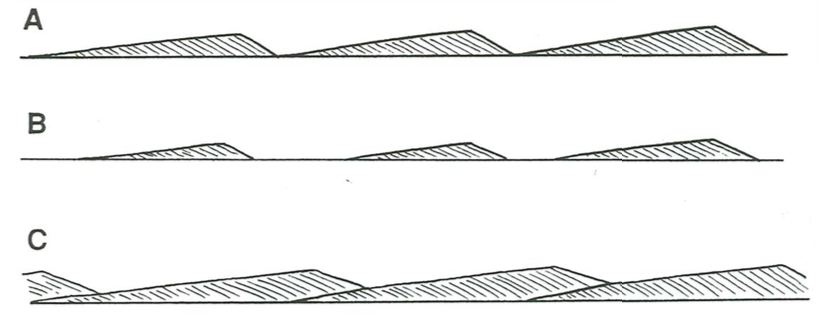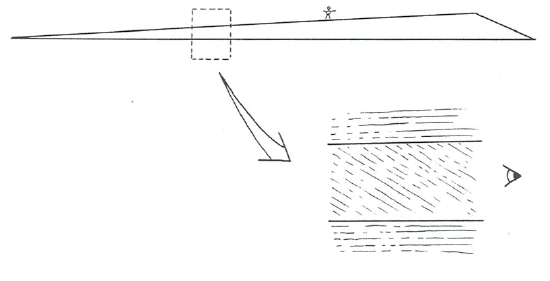16.5: Cross Stratification Not Produced by Climbing Bed Forms
- Page ID
- 4257
After all of the voluminous material above on how to deal with cross stratification produced by trains of repetitive bed forms that climb at some angle owing to net aggradation of the bed, I think that it is important to point out here that not all cross stratification is produced by bed forms climbing at some angle— although I think it is fair to say that most of the cross stratification you see is indeed formed in that way.
One obvious case in point is rather obvious, and has been touched upon in the earlier part of this chapter:
a train of flow-transverse bed forms is produced by a neutral flow (by “neutral” I mean that there is neither net aggradation or net degradation) over a loose sediment bed, then the flow stops, and later the train of bed forms is mantled or draped by sediment deposited in such a way as not to disturb that underlying train of bed forms (by fallout without traction, for the most part).
I might term this kind, unofficially, single-bed-form-train cross stratification.
I have already shown one example of single-bed-form-train cross stratification in Figure 16.4.9, wherein two-dimensional oscillation ripples are formed and shift slowly with no net addition of sediment to the bed. Single trains of unidirectional-flow ripples are more common. Cross stratification of this kind is especially common in deposits of distal turbidity currents. The situation is this: an almost exhausted turbidity current sweeps by a point, depositing fine sand, and molds that sand into a train of ripples. Although the bed is aggrading while the ripples are moving, the total thickness of sand added to the bed is not enough to form a layer more than one ripple thick (Figure \(\PageIndex{1}\)A). In fact, in many such cases the ripples end up starved, in the sense that the difficultly erodible substrate is exposed in the ripple troughs (Figure \(\PageIndex{1}\)B). Of course, as the total thickness of sediment added to be bed increases, the degree of overlapping of ripples (whereby ripples start climbing up the backs of others) increases (Figure \(\PageIndex{1}\)C), and eventually the picture is as described in the earlier section on classic climbing-ripple cross stratification.

Usually the material presented so far in this section is relevant to small- scale bed configurations—ripples of various kinds—but sometimes single trains of much larger dunes are formed and then interred within different, or at least differently structured, sediment. When the dunes have large spacings and small height-to-spacing ratios, there is the added complication that you may on the outcrop see a segment of a dune that is very short relative to the dune spacing, and the cross stratification looks like a planar-tabular set with uniform thickness (Figure \(\PageIndex{2}\)). I know of no way of knowing, just from looking at an outcrop like Figure \(\PageIndex{2}\), what the original spacing of the dunes was—or even if I am really dealing with a train of dunes in the first place!

In a situation like that shown in Figure \(\PageIndex{2}\), there is also the problem of whether the full height of the dune is preserved. You might find features at the upper surface of the cross set that gives evidence of its having been the exposed upper surface of a dune, like superimposed smaller bed forms. Although that is not foolproof, it would suggest strongly that the dune was not eroded or shaved off by a later strong current after its own driving current ceased.
Finally, cross stratification can be formed by the progradation of the sloping surface of an isolated element of positive relief, like a fluvial sand bar or a submarine shoal or a delta body. Scales of such features can range up to very large. Deciding between this situation and the one described above (a small part of a single train of dunes) would be impossible without a degree of lateral control not usually available in outcrop.
Chapter 16 Reading List
Alexander, J., Bridge, J.S., Cheel, R.J., and Leclair, S.F., 2001, Bedforms and associated sedimentary structures formed under supercritical water flows over aggrading sand beds: Sedimentology, v. 48, p. 133-152.
Allen, J.R.L., 1963, The classification of cross-stratified units with notes on their origin: Sedimentology, v. 2, p. 93-114.
Allen, P.A., 1985, Hummocky cross-stratification is not produced purely under progressive waves: Nature, v. 313, p. 562-564.
Arnott, R.W.C., and Hand, B.M., 1989, Bedforms, primary structures and grain fabric in the presence of suspended sediment rain: Journal of Sedimentary Perology, v. 59, p. 1062-1069.
Bridge, J.S., 1997, Thickness of sets of cross strata and planar strata as a function of formative bed-wave geometry and migration, and aggradation rate: Geology, v. 25, p. 971-974.
Cheel, R.J., 1990, Horizontal lamination and the sequence of bed phases and stratification under upper-flow-regime conditions: Sedimentology, v. 37, p. 517- 529.
Dott, R.H., Jr., and Bourgeois, J., 1982, Hummocky stratification: Significance of its variable bedding sequences. Geological Society of America, Bulletin, v. 93, p. 663-680.
Duke W.L., Arnott, R.W.C., and Cheel, R.J., 1991, Shelf sandstones and hummocky cross-stratification: new insights on a stormy debate: Geology, v. 19, p. 625-628.
Dumas, S., Arnott, R.W.C., and Southard, J.B., 2005, Experiments on oscillatory-flow and combined flow bed forms: implications for interpreting parts of the shallow- marine sedimentary record: Journal of Sedimentary Research, v. 75, p. 501-513.
Hand, B.M., 1969, Antidunes as trochoidal waves: Journal of Sedimentary Petrology, v. 39, p. 1302-1309.
Hand, B.M., 1974, Supercritical flow in turbidity currents: Journal of Sedimentary Petrology, v. 44, p. 637-648.
Hand, B.M., Wessel, J.M., and Hayes, M.O.,1969, Antidunes in the Mount Toby Conglomerate (Triassic), Massachusetts: Journal of Sedimentary Petrology, v, 39, p. 1310-1316.
Harms, J.C., Southard, J.B., and Walker, R.G.,. 1982, Structures and Sequences in Clastic Rocks: Society of Economic Paleontologists and Mineralogists, Short Course 9, variously paginated.
Hill, P.R., Meulé, S., and Longuépée, H., 2003, Combined-flow processes and sedimentary structures on the shoreface of the wave-dominated Grande-riviére- de-la-Baleine delta: Journal of Sedimentary Research, v. 73, p. 217-226.
Hunter, R.E., 1977a, Basic types of stratification in small eolian dunes: Sedimentology, v. 24, p. 361-387.
Hunter, R.E., 1977b, Terminology of cross-stratified sedimentary layers and climbing- ripple structures: Journal of Sedimentary Petrology, v. 47, p. 697-706.
Jopling, A.V., and Richardson, E.V., 1966, Backset bedding developed in shooting flow in laboratory experiments: Journal of Sedimentary Petrology, v. 36, p. 821-825.
Leclair, S.F., 2002, Preservation of cross-strata due to the migration of subaqueous dunes: an experimental investigation: Sedimentology, v. 49, p. 1157-1180.
Lowe, D.R., 1988, Suspended-load fallout rate as an independent variable in the analysis of current structures: Sedimentology, v. 35 , p. 765-776.
Massari, F., 1996, Upper-flow-regime stratification types on steep-face, coarse-grained, Gilbert-type progradational wedges (Pleistocene, southern Italy): Journal of Sedimentary Research, v. 66, p. 364-375.
Nøttvedt, AS., and Kreisa, R.D., 1987, Model for the combined-flow origin of hummocky cross-stratification: Geology, v. 15, p. 357-361.
Paola, C., and Borgman, L., 1991, Reconstructing random topography from preserved stratification: Sedimentology, v. 38. p. 553-565.
Prave, A.R., and Duke, W.L., 1990, Small-scale hummocky cross-stratification: a form of antidune, stratification?: Sedimentology, v. 37, p. 531-539.
Rubin, D.M., and Hunter, R.E., 1982, Bedform climbing in theory and nature: Sedimentology, v. 29, p. 121-138.
Schmincke, H.-U., Fisher, R.V., and Waters, A.C., 1973, Antidune and chute and pool structures in base surge deposits of the Laacher See area, Germany: Sedimentology, v. 20, p. 553-574.
Shaw, J., and Kellerhals, R., 1977, Paleohydraulic interpretation of antidune bedforms with applications to antidunes in gravel: Journal of Sedimentary Petrology, v. 47, p. 257-266.
Sherman, D.J., and Greenwood, B., 1989, Hummocky cross-stratification and post- vortex ripples: length scales and hydraulic analysis: Sedimentology, v. 36, p. 981-986.
Skipper, K., 1971, Antidune cross-stratification in a turbidite sequence, Cloridorme Formation, Gaspé, Quebec: Sedimentology, v. 17, p. 51-68.
Southard, J.B., and Boguchwal, L.A., 1990, Bed configurations in steady unidirectional water flows. Part 2. Synthesis of data: Journal of Sedimentary Research, v. 60, p. 658-679.
Storms, J.E.A., van Dam, R.L., and Leclair, S.F., 1999, Preservation of cross-sets due to migration of current ripples over aggrading and non-aggrading beds: comparison of experimental data with theory: Sedimentology, v. 46. p. 189-200.
Walker, R.G., 1967, Upper-flow-regime bed forms in turbidites of the Hatch Formation, Devonian of New York State: Journal of Sedimentary Petrology, v. 37, p. 1052- 1058.
Yagishita, K., 1994, Antidunes and traction-carpet deposits in deep-water channel sandstones, Cretaceous, British Columbia, Canada: Journal of Sedimentary Research, v. 64, p. 34-41.


